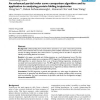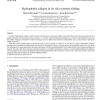420 search results - page 53 / 84 » A graphical model for predicting protein molecular function |
ISMB
1994
13 years 9 months ago
1994
In this paper, westudy the application of an ttMM(hidden Markov model) to the problem of representing protein sequencesby a stochastic motif. Astochastic protein motif represents ...
BMCBI
2005
13 years 7 months ago
2005
Background: We present a biological data warehouse called Atlas that locally stores and integrates biological sequences, molecular interactions, homology information, functional a...
BMCBI
2008
13 years 8 months ago
2008
Background: Understanding how proteins fold is essential to our quest in discovering how life works at the molecular level. Current computation power enables researchers to produc...
CANDC
2006
ACM
13 years 8 months ago
2006
ACM
A model of hydrophobic collapse, which is treated as the driving force for protein folding, is presented. This model is the superposition of three models commonly used in protein ...
ICML
2004
IEEE
14 years 8 months ago
2004
IEEE
Kernel conditional random fields (KCRFs) are introduced as a framework for discriminative modeling of graph-structured data. A representer theorem for conditional graphical models...


